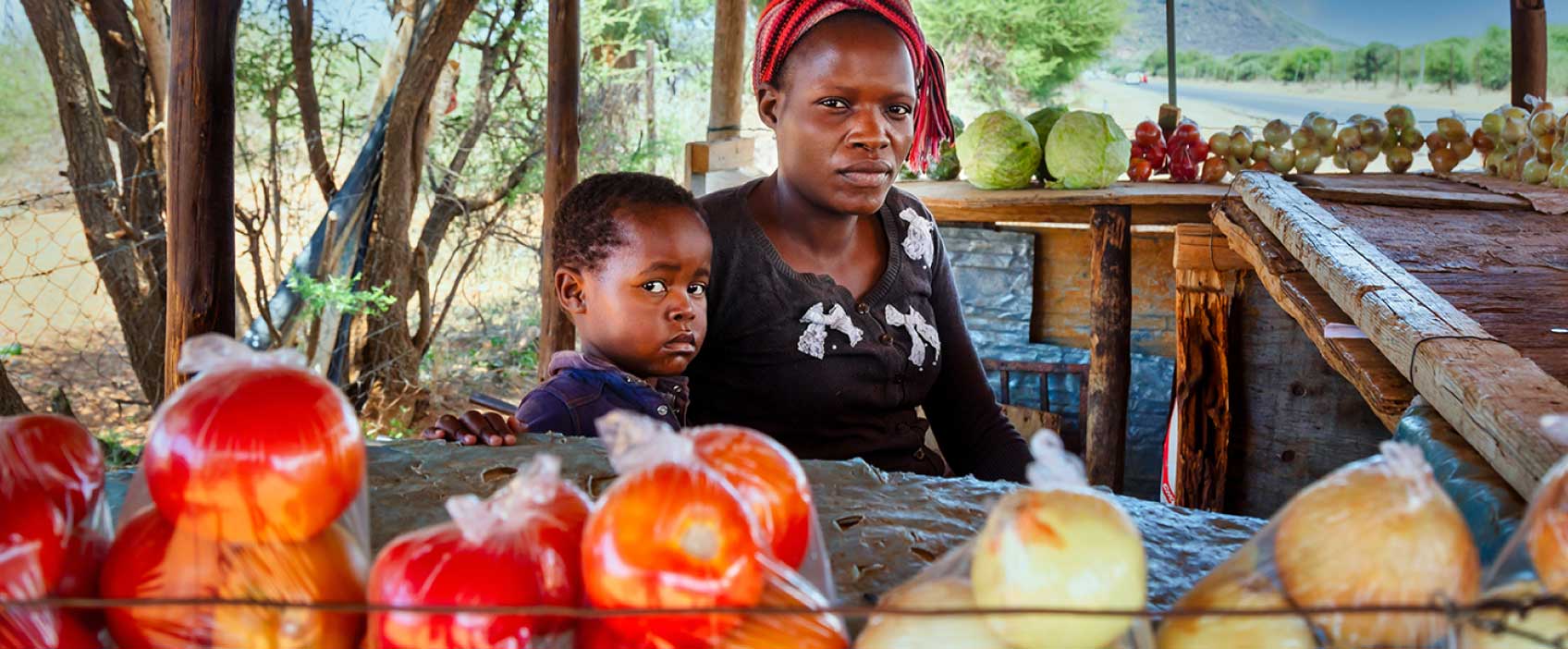
Publications and Datasets
IFPRI publications provide evidence-based insights and analysis on critical issues related to policies for food systems, food security, agriculture, diets and nutrition, poverty, and sustainability, helping to inform effective policies and strategies. Materials published by IFPRI are released under a Creative Commons license, and are available for download. IFPRI authors also publish in external sources, such as academic journals and books. Where possible we provide a download link for the full text of these publications.
Featured Publications
Journal Article
Disruptions and adaptations of an urban nutrition intervention delivering essential services for women and children during a major health system crisis in Dhaka, Bangladesh
2025…more
Frongillo, Edward A.Journal Article
Computer vision–assisted dietary assessment through mobile phones in female youth in urban Ghana: Validity against weighed records and comparison with 24-h recalls
2024…more
Folson, GloriaJournal Article
Compliance with food safety measures and their economic impact on smallholder dairy farmers: Evidence from the Indo-Gangetic plains of India
2024Katoch, Sonali; Kumar, Anjani; Kolady, Deepthi E.; Sharma, KritiExplore Our Latest Publications
By Title By Author By Country/Region By Keyword
Report
Myanmar Monthly Food Price Report – November 2024
Journal Article
Fertilizer and conflicts: Evidence from Myanmar
Journal Article
Fertilizer demand and profitability amid global fuel-food-fertilizer crisis: Evidence from Ethiopia
Journal Article
Adapting the Women’s empowerment in nutrition index: Lessons from Kenya
Journal Article
Adapting the women’s empowerment in nutrition index: Lessons from Kenya
Journal Article
Armed conflict and gendered participation in agrifood systems: Survey evidence from 29 African countries
Journal Article
The long-run and intergenerational impact of early exposure to the Great Chinese Famine of 1959–61 on mental health
Preprint
Intrahousehold dynamics in South Asia: Understanding the relationships between women’s empowerment, task sharing, decision making, and diets among women
Brief
Nepal: Systematic analysis of climate and world market shocks
Report
IFPRI Malawi monthly maize market report, December 2024
Brief
Agricultural advisory services in Tajikistan: Private sector role
Brief
Use of fertilizers in agriculture sector of Tajikistan
Brief
Agrifood trade in Tajikistan
Working Paper
The political economy of food self sufficiency policies and food security in African countries
Brief
Agriculture sector reform and sectoral programs in Tajikistan
Journal Article
The power of the anticorruption campaign: Evidence from cigarette and alcohol consumption in China
Journal Article
Biofortification as a food-based strategy to improve nutrition in high-income countries: A scoping review
Journal Article
Trends and inequities in adequacy of micronutrient intakes in rural Bangladesh
Journal Article
Levelling the field: A review of the ICT revolution and agricultural extension in the Global South
Journal Article
Polycentric governance of commons through multi-stakeholder platforms: Insights from two case studies in India
Journal Article
Do youth work in agriculture? Short-term dynamics of on-farm rural youth employment in Tanzania and Malawi
Journal Article
Evaluating the gendered credit constraints and uptake of an insurance-linked credit product among smallholder farmers in Kenya
Journal Article
Identification, characterization, and determinants of dietary patterns of low-income urban adults in Vietnam and Nigeria
…more
Mai, Truong Tuyet; Lundy, Mark; Bakk, Zsuzsa; Brouwer, Inge D.Journal Article
Can survey design reduce anchoring bias in recall data? Evidence from smallholder farmers in Malawi
Journal Article
Africa’s manufacturing puzzle: Evidence from Tanzanian and Ethiopian firms
Journal Article
In good times and in bad, in sickness and in health: The continuous rise in adoption of labour-saving agricultural technologies in Myanmar
Journal Article
Using best-worst scaling to inform agroecological interventions in Western Kenya
Journal Article
Resilience in technical efficiency and enabling factors: Insights from panel farm enterprise surveys in Kazakhstan and Uzbekistan
Journal Article
The political economy of agroecological transitions: Key analytical dimensions
Journal Article
Sustainable poverty reduction through social assistance: Modality, context, and complementary programming in Bangladesh
Journal Article
Men can cook: Effectiveness of a men’s engagement intervention to change attitudes and behaviors in rural Ethiopia
Journal Article
Neonatal mortality risk of vulnerable newborns by fine stratum of gestational age and birthweight for 230 679 live births in nine low- and middle-income countries, 2000-2017.
…more
Baqui, Abdullah H; Saha, Samir K; Ahmed, Salahuddin; Roy, Arunangshu Dutta; Silveira, Mariângela F; Buffarini, Romina; Shapiro, Roger; Zash, Rebecca; Kolsteren, Patrick; Lachat, Carl; Huybregts, Lieven; Roberfroid, Dominique; Zhu, Zhonghai; Zeng, Lingxia; Gebreyesus, Seifu H; Tesfamariam, Kokeb; Adu-Afarwuah, Seth; Dewey, Kathryn G; Gyaase, Stephaney; Poku-Asante, Kwaku; Boamah Kaali, Ellen; Jack, Darby; Ravilla, Thulasiraj; Tielsch, James; Taneja, Sunita; Chowdhury, Ranadip; Ashorn, Per; Maleta, Kenneth; Ashorn, Ulla; Mangani, Charles; Mullany, Luke C; Khatry, Subarna K; Ramokolo, Vundli; Zembe-Mkabile, Wanga; Fawzi, Wafaie W; Wang, Dongqing; Schmiegelow, Christentze; Minja, Daniel; Msemo, Omari Abdul; Lusingu, John P A; Smith, Emily R; Masanja, Honorati; Mongkolchati, Aroonsri; Keentupthai, Paniya; Kakuru, Abel; Kajubi, Richard; Semrau, Katherine; Hamer, Davidson H; Manasyan, Albert; Pry, Jake M; Chasekwa, Bernard; Humphrey, Jean; Black, Robert EJournal Article
Rural underemployment and urbanisation: Insights from a 9-year panel from Malawi
Journal Article
Wholesalers and the transformation of Myanmar’s maize value chains
Journal Article
Designing and implementing experiments within local bureaucratic systems: A cautionary tale from an educator incentive program
Journal Article
What do urban consumers want? Findings from a discrete choice experiment on the preference for locally produced staple food in Central Africa: Evidence from the Democratic Republic of Congo (DRC)
Journal Article
Economic impacts of large dams on downstream brickmaking in developing countries
Journal Article
Technology intensification and farmers’ welfare: A case study from Karnataka, a semi-arid state of India
Journal Article
Information framing effects on diet choices among Chinese urban residents
Journal Article
Agribusiness innovation, value chain interventions, farmer input use, agricultural productivity, land access and asset ownership
Journal Article
The costs of a multisectoral nutrition program implemented through a poultry value chain platform in Burkina Faso
Journal Article
Assessing global price shocks and mitigation policies on welfare and food security in Nigeria
Journal Article
Educational responses to local and migration destination shocks: Evidence from China
Journal Article
Vulnerability of Nigerian maize traders to a confluence of climate, violence, disease and cost shocks
Journal Article
Does aid induce foreign direct investment: Updated evidence from a quasi-experiment
Journal Article
Caste, religion and the labor force participation of women: Evidence from India
Journal Article
Rethinking responses to the world’s water crises
…more
Robin, Libby; Talbot-Jones, Julia; Wheeler, Sarah Ann; Avarado, Fabiola; Hope, Robert; Biswas, Asit K.; Borgomeo, Edoardo; Brouwer, Roy; Costanza, Robert; Kubiszewski, Ida; Kompas, Tom; McDonnell, Rachael; Martins, Rita; Nikolakis, William; Rollason, Russell; Samnakay, Nadeem; Scanlon, Bridget R.; Svensson, Jesper; Thiam, Djiby; Tortajada, Cecilia; Wang, YahuaJournal Article
Disruptions and adaptations of an urban nutrition intervention delivering essential services for women and children during a major health system crisis in Dhaka, Bangladesh
…more
Frongillo, Edward A.Journal Article
Shocks and stability of risk and time preferences among poor rural households in Ethiopia
Journal Article
Combine harvester outsourcing services and seasonal rural non-farm employment in Myanmar
Journal Article
Food transfers, cash transfers, behavior change communication and child nutrition: Evidence from Bangladesh
Journal Article
Identification, characterization, and determinants of dietary patterns of low-income urban adults in Vietnam and Nigeria
…more
Mai, Truong Tuyet; Lundy, Mark; Bakk, Zsuzsa; Brouwer, Inge D.Journal Article
Diets, fruit and vegetables consumption, and nutritional status in Benin: A scoping review
Journal Article
The role of industrial clustering: From layoff to self-employment after the Chinese state-owned enterprise reform
Journal Article
Using a list experiment to measure intimate partner violence: Cautionary evidence from Ethiopia
Journal Article
Prospects of crop insurance for sustenance of farmers’ livelihood during GM cotton crop failure in Indian Punjab
Opinion Piece
Relapse after recovery from acute malnutrition
Journal Article
Unpacking power dynamics and women’s economic empowerment in polygynous households in Burkina Faso
Journal Article
Methods for estimating beneficiary populations targeted by health and nutrition interventions for women, pregnant women, infants, and young children
Journal Article
Diets, fruit and vegetable intake and nutritional status among children, adolescents and adults in the Philippines: A scoping review
Journal Article
Conflicts, crop choice, and agricultural investments: Empirical evidence from Nigeria
Working Paper
Global rice market: Current outlook and future prospects
Report
2024 China and global food policy report: Building a sustainable and diversified food supply to foster agrifood systems transformation
Working Paper
How agri-food value chain employment and compensation evolve with structural transformation
Brief
Stakeholder feedback on a slaughterhouse hygiene intervention in western Kenya
Brief
Formative study on slaughterhouse hygiene in Western Kenya: Summary Report
Brief
Impact of a slaughterhouse hygiene intervention in western Kenya
Working Paper
Leveraging the role of MSMEs for healthier diets and nutrition: Insights from fruit and vegetable value chain studies across five countries
Working Paper
Business and public health impacts of a food safety rating program among pork vendors in Vietnam
Brief
Monitoring the agri-food system in Myanmar: Rice millers – September 2024 survey round
Brief
National seminar on Regulations and Governance Issues in India’s Seed Sector: 26-27 September 2023, New Delhi
Brief
Unlocking Innovation in homestead farms: Exploring drivers and barriers to innovation adoption among farming households in Uzbekistan
Working Paper
The effects of conflict-induced migration on food security and health related outcomes in Sudan: From displacement to despair
Working Paper
Subsidizing resilience: Evaluating Kenya’s fertilizer subsidy program amid global supply chain disruptions
Brief
Strengthening women’s voice and agency in Nigeria: Evidence from a randomized control trial on women’s advocacy and men’s allyship trainings
Brief
Effet de l’insécurité (conflit armé) sur l’autonomisation des femmes au Burkina Faso
Brief
Evaluating hydropower and irrigation development in Sudan under climate change uncertainties
Working Paper
Do empowerment impacts endure? The medium-term impacts of the Agriculture, Nutrition, and Gender Linkages (ANGeL) Project in Bangladesh
Brief
Integrating consumer traits is key to increasing uptake of improved crop varieties: Evidence and policy insights from seed sample packs and cooking events in Uganda
Working Paper
Empowerment after migration: Exploring the association between migration and the empowerment of women who stay behind
Brief
Small groceries in Viet Nam
Working Paper
Options for reducing greenhouse gas emissions from agriculture and food systems
Brief
Enhancing women’s economic empowerment in rural Nigeria through advocacy trainings
Working Paper
Promoting adoption of sustainable land management technologies by women and couples in Ethiopia: Evidence from a randomized trial
Working Paper
Farming under fire: The interplay of armed conflict and climate-induced weather disruptions in agricultural input use
Working Paper
Do public works investments in watershed rehabilitation and small-scale irrigation improve nutrition and resilience? Evidence from bureau for humanitarian assistance interventions in support of Ethiopia’s productive safety net program
Brief
Mapping energy use portfolios and household outcomes in Nepal: Insights from farm and household surveys in the Terai and the Mid-hills
Brief
Financial and environmental outlook of groundwater-solar irrigation in sub-Saharan Africa
Brief
Targeting in development projects in Egypt: Approaches, challenges, and lessons learned
Working Paper
Don’t spend it all in one place: The medium-term effects of a national cash transfer program on household well-being
Data Paper
Migration and empowerment: Data from a follow-up survey among a sample of households in western Honduras
Brief
Social assistance and adaptation to flooding in Bangladesh
Brief
Building pathways out of poverty in Baidoa: Evidence from a randomized controlled trial at endline
Working Paper
Prioritizing agri-food system investments under climatic and world price risks
Working Paper
Income, employment, transfers, and household welfare dynamics before and during the conflict in Sudan
Dataset
Migration Propensity Index Validation Survey, Honduras
Working Paper
Why do multistakeholder processes emerge and flourish? Identifying and operationalizing the leading hypotheses
Dataset
SPIR II Group Problem Management Plus (gPM+) Baseline Survey in Tigray, Ethiopia
Dataset
Strengthen PSNP Institutions and Resilience Phase II (SPIR II), Ethiopia: Group Problem Management Plus (g-PM+) Pilot, Follow-up 2
Working Paper



